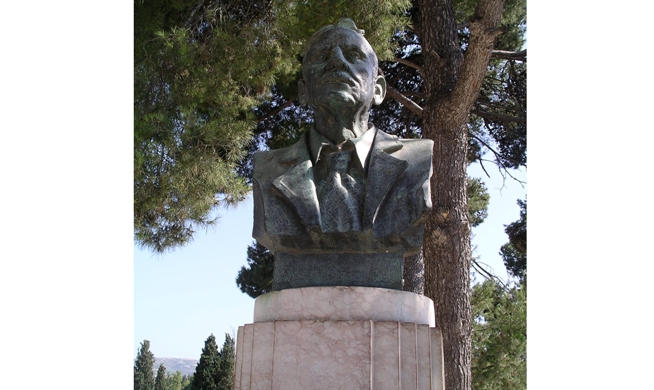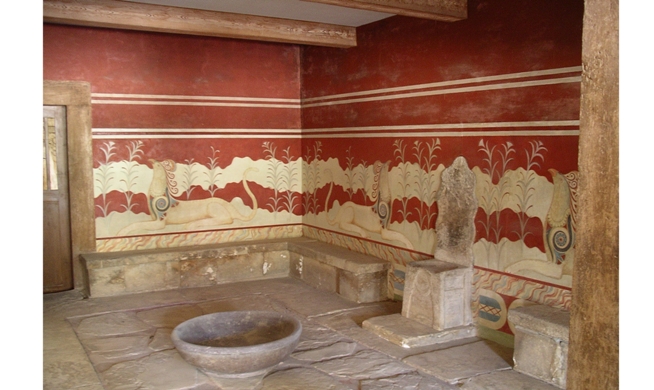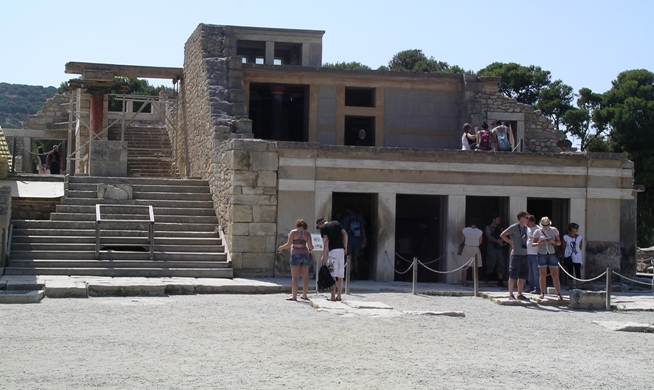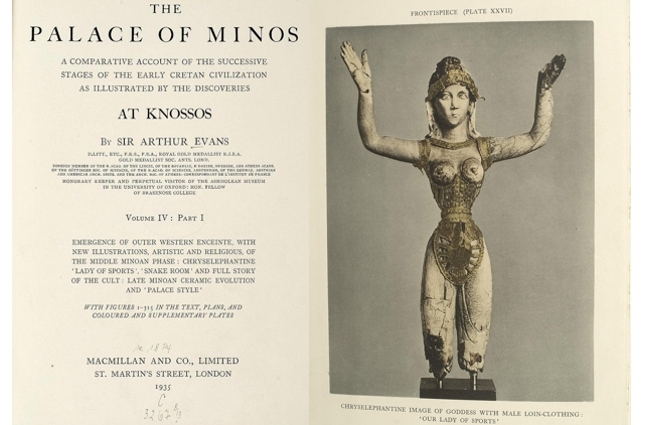The Evans Connection Part 1: The Minoans Discovered
Published
Categories
Author

Blog Post
Here I continue the story of an icon of the Royal Ontario Museum (ROM) collection: the ivory and gold female figurine–ROM 931.21.1. For further information see the ‘Minoan’ Ivory Goddess Research Project.
I discuss why the Museum, or indeed anyone, believed that the figurine was genuine. In essence, this was based on the opinion of one man, Sir Arthur Evans (as I explain in an earlier article [6591]), but to understand why, I must consider the bigger picture of the discovery and, to some extent, the ‘creation’ of the ancient Minoans at the beginning of the 20th century.
"It would be a bold man, or a very silly one, who would challenge Sir Arthur’s opinion."
letter from C. T. Currelly (ROM Director) to L.J. Simpson, Ontario Minister of Education, 6th November, 1935
As Currelly’s words suggest, Sir Arthur Evans was the single most influential person to have shaped modern understanding of the Minoan civilisation. A wealthy English archaeologist, it was Evans who excavated the ‘palace’ at Knossos on Crete, and who coined the term ‘Minoan’ to describe the Bronze Age people who had lived there and elsewhere on Crete. Evans was considered the expert, with experience of the material and a good eye for detail.
"I suppose over 90 per cent of all objects found in Crete have been in his hands for examination, and the then director of the National Museum of France said to me years ago, “When Evans says a thing, I accept it without question."
letter from C.T. Currelly to L.J. Simpson 6th November, 1935
Archaeology is not an exact science. Material remains might be objective evidence about an ancient civilisation, but this evidence must be interpreted, and this cannot be a neutral and objective activity. All interpretation of archaeological evidence is coloured by preconceptions and contemporary experience. In recent years more self-reflexive examinations of Sir Arthur Evans have shown that he was very much a product of his time, influenced by his family background and his own personal, academic, and political experiences. I will explore some of these here.
Background & Influences
The Evans family had been interested in archaeology for generations. Arthur Evans’ grandfather ran a school for boys and was a keen collector of books, coins, and fossils found at local sites with his sons. John Evans, father of Arthur Evans, had no university degree, but was so ambitious and intelligent that soon after Arthur was born in 1851 he owned a successful paper mill business, as well as being a well-respected scholar specializing in numismatics and the archaeology of early Britain. John’s approach to the new ‘science’ of archaeology owed much to his interest in geology. Geologists were acknowledging for the first time just how ancient the earth truly was, and recognizing the significance of geological stratigraphy in determining the different phases of development. This new approach had implications for both the history of the earth, and of early man, proving that there was a prehistoric period of evolution, in contrast to the commonly-accepted biblical explanation of the creation of the earth. It was to tie into the world of natural sciences when Charles Darwin published his theory of evolution The Origin of the Species in 1859.

Portrait of Sir Arthur Evans set up at Knossos, Crete | Photo: Kate Cooper, 2011
Arthur Evans himself enjoyed a privileged childhood in this wealthy and intellectual family, although it was marred by his mother’s death when he was just six. Evans was well-educated, first at Harrow then at Oxford where he studied Modern History, but he was always seen as being intellectually rebellious and arrogant–this independence of thought, as well as the income from the family business, would later allow him to devote so much energy, time, and money to his archaeological work. Since his undergraduate years Evans had travelled in the Balkans, an area deeply divided by war as nationalists rebelled against the weakening Ottoman rule. The horrors of these struggles made a great impression on him, and he sought to publicise the Balkan political situation, supporting independence. He settled for a while in Ragusa (now Dubrovnik) and became a foreign correspondent on the Balkans for the Manchester Guardian, before being forced to leave after being arrested as a suspected spy. Back in England, in 1884 he was made Keeper of the Ashmolean Museum, Oxford, where he slowly revolutionized the long-neglected museum and eagerly promoted the importance of the prehistoric Mediterranean in the face of the traditional interests of the academic establishment. At this time, British academics focused on the literary texts and artistic remains of Classical Greece and particularly those of democratic Athens of the 5th century BCE. The marble sculptures of the Parthenon, brought to England by Lord Elgin in the early 19th century, were admired as the best of Greek artistic achievement. This narrow focus on Classical Greece did not interest Evans, who wanted instead to discover earlier phases of the people of the Aegean.
During much of the 19th century Greece had not been an area of archaeological exploration, since it was under Ottoman rule and relatively inaccessible to foreign travelers. Instead, archaeological work had concentrated on the Middle East. In Egypt, following the explorations by Napolean Bonaparte’s teams of scholars in the late 18th century, the royal pyramids of the Valley of the Kings at Luxor were ‘excavated’ (more treasure hunt than excavation) from the early 19th century, and in 1884 W.M. Flinders Petrie began controlled excavations at Tanis. Similar discoveries were taking place in the ancient Near East, where the Mesopotamian centres of Nimrud and Ninevah were first excavated in the middle of the 19th century.
It was only with the discoveries of an ‘amateur archaeologist’ of almost legendary status that the prehistoric Aegean began to take centre-stage. Heinrich Schliemann was a German businessman who used his self-made fortune to search for the archaeological truth behind the tales of Homer. Guided by Homer’s Iliad (and building on discoveries made by others), in 1871 Schliemann began uncovering ancient Troy, site of the Trojan war, near modern Çannakule in Turkey. In 1876 he turned his attention to mainland Greece and discovered the citadel of Mycenae, legendary home of Agamemnon who, according to myth, led the Greeks against the Trojans. Schliemann lavishly published his discoveries and gave many lectures. He was particularly popular in England, where the Trojan treasures were exhibited in 1877 at the South Kensington Museum (now the Victoria & Albert Museum). In 1883 Evans toured Greece, visiting the excavations at Mycenae and meeting Schliemann himself. In many ways Evans was to follow in the footsteps of Schliemann.
Schliemann’s fabulous and much-publicized prehistoric remains revealed his early Greeks, named the Mycenaeans after the city of Mycenae, to be a warlike, male-dominated society. It was against this background that Evans was to uncover and interpret the finds from his own early ‘Greek’ culture. Unlike the Mycenaean civilization, Evans stressed that his Minoan civilization was one of peace. According to him, the Minoans did not need fortifications for their great palace centres, despite living on a small island. This is just one example of how Evans was conveniently selective with the archaeological evidence, since he had himself discovered traces of fortifications while exploring the Cretan countryside in 1895 before beginning his excavations at Knossos.
The picture that Evans was to paint of the Minoans as a peaceful civilization which flourished for centuries, was also extremely attractive to his war-weary contemporaries. At the beginning of the 20th century Europe had only recently recovered from the effects of the Napoleonic wars, and the Mediterranean and Balkans were still ravaged by conflict between the weakening Ottoman Empire and their subject nations struggling to gain independence. The disintegration of the Ottoman empire and the shifting balance of power eventually led to the events that sparked World War I in 1914. Evans had already experienced first-hand the terrible ethnically- and religiously-driven conflict in the Balkans, and again on Crete, and idealistically he hoped his excavation at Knossos could be a place of peace and unity. He employed both Muslim and Christian workmen on his excavation and had them celebrate joint holidays together with games and dances.
Evans’ vision of the Minoan past drew on myths as well as the archaeological remains. Although Crete’s prehistoric past remained forgotten until the 20th century (it is unlikely that even the Classical Greeks knew about the reality of the Bronze Age), several ancient Greek myths survived which were set on the island – those of King Minos and Pasiphae, the Minotaur in his labyrinth, Theseus and Ariadne. To Evans, influenced by contemporary developments in the study of anthropology and mythology, these were evidence of cultural ‘memories’ which preserved remnants of actual events. He believed that Knossos was the palace of Minos, although he rationalized the myth by deciding that ‘Minos’ was the hereditary title for every Minoan ruler. By describing different artefacts in terms of personalities from myth, such as the ‘bath of Ariadne’ and the ‘throne of Minos’, he brought the archaeological remains to life.

The ‘throne of Minos’ in the Throne-room at the ‘palace’ of Knossos | Photo: Kate Cooper, 2011
Evans was particularly interested in the importance of Ariadne, mythical daughter of Minos. She appeared throughout his interpretation of the archaeological evidence either as Queen Ariadne, or as the Great Mother Goddess, who was the central figure in his view of Minoan religion. Evans imagined the Minoans as an extraordinarily matriarchal society, in contrast to the more male-dominated Mycenaeans (or Victorians and Edwardians of his own time). Some scholars have attributed Evans’ almost obsessive focus on the Great Mother to a reaction to the death of his own mother while he was young, but the idea of a matriarchal society that flourished in the very earliest period of civilisation was also in keeping with theories current in the social sciences in the early 20th century about motherhood and the development of society from an early matriarchal stage of cultural evolution to patriarchal dominance.
The Discovery of Knossos
Evans became interested in the island of Crete when Cretan seal-stones were given to the Ashmolean museum. He realized that the images engraved on some of these tiny stones depicted an early pictographic writing system, previously unrecognized, and he believed they were evidence of a prehistoric civilization. In 1894 he first visited Crete looking for more prehistoric writing and he soon settled on the site of Knossos (then a hill known as Kephala) for further exploration. Here a local archaeologist, Minos Kalokairinos, had already made several stunning discoveries which had attracted archaeological interest. Many people, including Schliemann, had tried to acquire the rights to the site without success, until Evans, who was a supporter of the Cretans against the Ottoman rule, was eventually allowed to buy the land in 1899 after Crete declared independence. Excavations, funded and overseen by Evans, began at Knossos in 1900.
Knossos had captured Evans’ attention because of scattered clay tablets inscribed with the undeciphered script later known as Linear B (ironically, when this was finally translated after his death it disproved some of his theories). However, wanting to excavate the whole site scientifically, he took advice from colleagues at the British School of Archaeology at Athens and hired as his assistant Duncan Mackenzie, who had already worked on the excavation of prehistoric Phylakopi on the Cycladic island of Melos. What they uncovered over the following years was a huge building complex more than 2km2, which Evans named the ‘Palace of Minos’. It is now recognized that this was probably not the home of a royal family, but was instead an organizational, administrative and religious centre. The several phases of the Minoan ‘palace’ lasted from around the 20th to the mid-14th century BCE, when it suffered destruction. At its peak, the ‘palace’ was architecturally complex and lavishly designed and decorated, while the excavated artefacts demonstrated that the Minoans had a wide network of foreign contacts and were skillful craftsmen.

The ‘palace’ of Knossos showing a view from the Central Court of the Stepped Portico and Throne Room Complex which was restored to three storeys between 1922 and 1930 | Photo: Kate Cooper, 2011
The scale of the archaeological remains uncovered was amazing, as can be seen in a plan of the site published in 1902 by Theodore Fyfe, the first project architect. It was clear that they needed protection, and after unsuccessful temporary measures, Evans focused his resources on a more permanent solution. Between 1905 and 1930 areas of the palace were partially rebuilt in reinforced concrete, under the supervision of the project architects Christian Doll, then Piet de Jong. This was one of the first large-scale uses of reinforced concrete, which had only been invented in the 1860s, and it allowed some palace building to be restored to several storeys. The huge visual impact of the reconstruction was extremely influential but was also highly controversial and much criticized, as I discuss in my next installment Part 2 The Minoans Created.
Evans promoted his discoveries through lectures and short publications, but did not fully publish his work until the 1920s and 1930s. The four volumes of The Palace of Minos A comparative account of the successive stages of the early Cretan civilization as illustrated by the discoveries at Knossos combined description of the excavations and finds from Crete with his own vision of the Minoan civilization, and told a detailed and beguiling story. This huge publication became a cornerstone of the academic study of the Minoans, although details of Evans’ theory were modified. However, it too has been criticized. Recent re-examinations of the original excavation notebooks kept by Duncan Mackenzie have shown that Evans was often guided by his pre-conceptions, rather than by the archaeological evidence. It is often hard to see where the evidence ends and Evans’ over-confident interpretation begins.

Frontispiece of volume 4.1 of The Palace of Minos by Sir Arthur Evans (1935)
It was the publication of the ROM ‘Minoan’ goddess in volume 4 of The Palace of Minos that convinced even those with doubts that she was indeed genuine:
…as a matter of fact I said just the opposite from what the newspapers quoted me as saying. I said that I suspected the ivory and gold Cretan statue in Toronto but that Sir Arthur Evans in his large new volume says it is genuine.
letter from D.M. Robinson (Professor of Archaeology, Johns Hopkins University) to H.A. Thompson (ROM Keeper of the Classical Collections) 11th November, 1935
For more on this exchange see my earlier article.
In tomorrow's article–Part 2: The Minoans Created – I will consider the way that Evans promoted his vision of the Minoans, which resulted in a thriving industry in replicas and fakes.
Further Reading
C.L. Cooper (Kate Cooper), 'Biography of the Bull-Leaper: A 'Minoan' Ivory Figurine and Collecting Antiquity', in Cooper C.L. (ed) New Approaches to Ancient Material Culture in the Greek & Roman World (Leiden: Brill, MGR 27, 2021). doi:10.1163/9789004440753_005
Cathy Gere, Knossos and the Prophets of Modernism (Chicago, 2009)
J. Alexander MacGillivray, Minotaur: Sir Arthur Evans and the archaeology of the Minoan myth (London, 2000)
J. Lesley Fitton, The Discovery of the Greek Bronze Age (London, 1995)
A. J. Evans, Palace of Minos: A Comparative account of the successive stages of the early Cretan civilization as illustrated by the discoveries at Knossos (London, 1921-1935)


